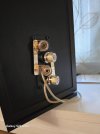Hello I wanted to ask if anyone here has had a similar experience. I have been into car audio for about 6 to 7 years. I have DSP inside my truck, which it helps create a center image. Now in my home stereo, I do not have a DSP. My receiver is a Nad. M10 V-2. The Nad reciever has dirac live but I have not got it working correctly. YET. I have a pair of Martin Logan Motion 4i bookshelf speakers the M.L.'s create a phantom image where the sound appears to come from the TV's center. I know the M.L.'s speakers have been measured here but don't seem to be very good when looked at through those measurements. It is when the M.L.'s are playing music or watching TV that I hear or see a phantom image of what's playing, band members in their places and actors in theirs.
I recently purchased a pair of Wharfdale 220's which have a good review here, where they measures quite well for thier class. I use them for my speakers for my TV and music. The image they produce is spaced out noticeable left and right. Everything is the same as with the M.L.'s. I ask myself why?
I am probably rambling but this is something I noticed.
I recently purchased a pair of Wharfdale 220's which have a good review here, where they measures quite well for thier class. I use them for my speakers for my TV and music. The image they produce is spaced out noticeable left and right. Everything is the same as with the M.L.'s. I ask myself why?
I am probably rambling but this is something I noticed.
